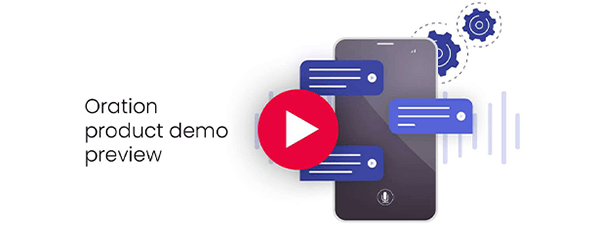On the surface, the idea of IVR deflection sounds like it carries negative connotations. Before we can understand how IVR deflection can be used to improve customer experiences, we must dive into the history of IVR deflection and how it came to be what it is today.

IVR deflection: The history of contact centre evolution
Traditional IVR systems caused a lot of dissatisfaction among customers because they were centred around offering callers myriad options and generic deflection messages which they must navigate to reach a resolution. One report even suggested more than 51% of consumers abandon a business due to poor experience with an IVR system. The problem with this approach was that these IVR systems created an impersonal customer experience. Unfortunately, this gave the impression that companies were more focused on putting up barriers to prevent callers from reaching real agents, rather than using the IVR to help the caller to get to a positive outcome. Using the IVR as a barrier leads to callers giving up without a resolution, clearly not a good outcome for the caller even though it does reduce calls in the contact centre.
Spending time on the phone navigating options and listening to automated generic information can be frustrating, and something so many of us have experienced several times before. 63% of participants in an IVR study conducted by Vonage rate IVR not tailoring these options to their individual needs as a core issue. It's not surprising, then, that many companies began to pull away from traditional IVR deflection methods, this included the use of generic targeted banners.
In the modern era, more and more contact centres are moving to more natural language IVR solutions, which are otherwise known as ‘conversational IVRs’. Replacing traditional limited menu options, conversational IVR solutions like Oration by Convai use natural language processing and artificial intelligence to understand what a customer is calling about from their own conversational speech. This offers a more ‘human-like’ and good customer experience by recognising natural conversation patterns to facilitate customer interactions and provides access to an unlimited range of options whilst appearing tailored and personal to the caller. This growing popularity of intelligent voice agents led a Gartner study to predict that by 2023, most consumers will prefer speech interfaces that initiate 70% of self-service customer interactions.
Conversational IVR allows customers to reach the resolution they need in a faster time, with less steps and with questions that relate to the caller. It also means that contact centres can offer customers an unlimited number of bespoke call outcomes which are not restricted to predetermined menu selection processes – this is known as intelligent call routing.
The aim is to get the call to the best outcome - that might be an agent but also might be a useful and informative voice banner for example. Unlike traditional IVR systems, the benefits work both ways - better for the contact centre and better for the customer.
For example, while the customer has a more seamless and successful experience on the phone, fewer calls need to be handled by agents which lower workloads and reduces costs. In other words, it’s IVR deflection but without the deflection – in the real sense anyway.
Boosting state-of-the-art ‘conversational IVR’ technology with IVR deflection
Up-to-date and sophisticated IVR solutions have mastered what it takes to deliver more personalised conversational interactions over the phone before an agent is involved – and that’s if they become involved at all. Importantly, by accurately understanding the nature of a call from a customer's natural language, the IVR can match callers with agents who have the right skills to offer the help they need and resolve issues in the fastest time.
Solutions like Oration are also able to transcribe information spoken by a caller before sending the information to agents’ screens via screen pop technology. The added benefits of conversational IVR means that contact centres can reduce average handling times and therefore, are in a much better position to handle peak periods and lower call waiting times.
With a clearer understanding of the evolution of contact centre technology, it’s easier to see how IVR deflection can take customer experience management to new heights. According to McKinsey, a company they studied redesigned their IVR system to focus on a customer-centric approach and increased their call containment rate 2% to 5% and improved call satisfaction ratings by 10% to 25%. To start with, it's critical to understand that the underlying principle of modern IVR deflection is not about blocking callers from reaching agents to reduce calls and save costs. Instead, IVR deflection technology in the modern contact centre is about recognising that different customers prefer to interact and receive information in multiple different ways.
What is IVR deflection?
Convai’s cloud-based IVR solution, Oration, has been designed so callers are not restricted to resolving their queries through just the voice channel. Whether that be interacting with the IVR and receiving automated responses or being put through to an agent. Oration has the capability to deflect callers to different, and often more appropriate channels such as messaging, to carry out their interactions.
For example, in one scenario, IVR deflection might mean that a caller receives a link via SMS either to simply view information or to enter data and carry out transactions via self-service applications. Similarly, IVR deflection might mean that a caller is diverted to live chat to avoid waiting in a call queue and be in a better position to read or receive information.
IVR deflection is the key to giving customers the omnichannel experiences that meet the customer expectations of today. Another huge advantage of offering an omnichannel customer service experience driven by IVR deflection is that customers can reach out and receive information quickly right around the clock. This is done without the restrictions of contact centre opening hours or agent availability.
When can IVR deflection take place?
IVR deflection is designed to be a flexible feature. This means it can take place at any stage in the customer journey and not necessarily be the first option selected by a caller at the start of their interaction.
For example, Oration’s call routing solution uses the power of artificial intelligence to interpret a customer’s language and determine their true intent. With this information, the technology can automatically route the call to the most appropriate outcome, which may include offering the chance to deflect to an alternative channel.
If a call is routed to an agent, agents themselves might offer the chance to deflect to another channel, either in-call or post-call. This is done if it turns out to be a more appropriate or convenient method for the customer to receive information or resolve the call. The benefit here is that while there has still been agent involvement, the agent spends less time on the phone while the customer is offered added value and convenience in the resolution process.

Spotlight on the top benefits of IVR deflection
- Improves customer service quality metrics
Your contact centre might be using NPS or CSAT survey scores to monitor customer satisfaction levels by analysing customer feedback. To start with, IVR deflection has the potential to shorten the length of time it takes to reach a resolution because customers can be deflected to another channel where the information they need is readily available. And around 43% of customers prefer contact centres that offer bots in order to simplify their customer service experience.
IVR deflection also lowers call waiting times while offering more convenient methods to interact with your customer service offering and solve problems, sometimes 24/7. Consequently, implementing IVR deflection is likely to result in an improvement to your contact centre’s performance metrics.
- Reduces the volume of calls reaching agents
Because the deflection options are personalised, some of your customers will choose alternative ways to interact or receive information other than speaking with an agent. This means your team of agents will have more time to spend resolving more complex queries over the phone. Similarly, by deflecting calls to other automated communication methods, your contact centre's human resources will experience less pressure during peak periods or when unforeseen events occur. In fact, Hubspot’s data-driven research report on customer service found 29% of businesses surveyed have live chat software installed to improve customer support and reduce their call agents workloads.
- Lowers the cost of operations
With more calls being handled automatically, and agents spending less time resolving basic queries, your staff headcount is likely to be lower than it would be in the absence of IVR deflection techniques. It's also important to remember that there can sometimes be intangible costs when your team of agents are put under undue pressure too frequently. This could include receiving a high volume of calls from very frustrated customers who have no alternative but to wait to speak to an agent, for example. This can sometimes lead to high staff turnover which, in turn, raises the cost of recruitment and training for new staff. Instead, the implementation of such processes can help streamline contact centre operations, with around 90% of businesses attributing this deflection to live chat software.
- Empowers your customers
There's no doubt that your customers like to feel in control of the resolutions they seek. However, a perceived lack of control when customers are at the mercy of call queues without alternative ways to interact is a common pain point of traditional contact centres. Fortunately, IVR deflection allows customers to feel as though they can manage their own experiences to suit their preferences and needs.
Around 60% of consumers attribute the most frustrating aspect of their customer experience to long wait times. Imagine a scenario where a customer becomes aware that there are extended waiting times to speak to an agent; IVR deflection might give the customer the opportunity to deflect to live chat for immediate assistance. Similarly, if a customer might be required to share data or information, they can choose to complete this safely and securely in their own time by receiving a link to a form through SMS.
Core IVR deflection techniques and outcomes
When it comes to building your IVR deflection strategy, it's important to remember that whatever you offer, it's about adding value and convenience to your customers. It should never be perceived as primarily serving the needs of the contact centre itself. Above all, you should avoid making your customers feel as though IVR deflection is their only option. Here are some key ways to bring IVR deflection into your contact centre in a way that benefits your callers.
Self-service
Customers are used to helping themselves using intuitive online platforms. In fact, many customers prefer to complete tasks themselves without feeling reliant on the availability of third parties to help them – and this goes back to the earlier point about feeling in control. Integrating your IVR call routing solution with user-friendly self-service functions means customers will be able to complete more tasks themselves without taking your agents' time. Around 40% of businesses are implementing self-service functions to resolve customer queries or issues more efficiently.
Sophisticated self-service methods might include allowing callers to:
- Check account balances or make payments through automated voice responses
- Complete forms or carry out other transactions online by sending links and deflecting to digital channels.
Deflection to SMS or live chat
Shifting an interaction to SMS can help your customers get resolutions faster while agents are empowered to serve more people in less time by responding with automatically generated text messages. IVR Deflection to SMS works by simply offering the caller the opportunity to continue the interaction via text before reaching an agent. If the customer agrees, the IVR will cease the voice communication and initiate a new conversation by sending an SMS to the number the caller is calling from.
Typically, a customer will choose SMS for less complex queries, which means an agent can quickly and easily provide the customer with the information they need while reserving more time for handling complex issues over the phone.
Deflection to live chat works in a similar way to SMS, giving agents and customers the opportunity to interact via text. However, switching to live chat by sending a link to the customer offers the added benefit of allowing customers to choose which digital device they use, such as their phone or computer.
Offer call-backs
While offering customers the chance to receive a call back won't help them seek an immediate resolution to their query, they will always appreciate not having to wait on hold for an indefinite period to speak to an agent. According to a survey by Software Advice, 63% of respondents would prefer a call back option over waiting on hold. When the caller accepts a callback, the IVR system records the number they're calling from, so the customer can Immediately hang up. Meanwhile, the IVR will notify agents when the customer has reached the front of the call queue, so they can call the customer to resolve their query. It's a simple, but incredibly customer-centric IVR deflection technique.

Conclusion
With knowledge of the history and evolution of contact centre technology, it's easy to appreciate why IVR deflection in the modern environment should never be confused with a tactic to avoid dealing with customers. By analysing the needs and preferences of your callers and building a responsive IVR deflection strategy, your contact centre will be better equipped to handle your call volumes. This, in turn, will improve customer satisfaction through more personalised and enhanced customer experiences.
Above all, your IVR deflection strategy should be created on the fundamental principle that every caller is different. Most importantly, offering an omnichannel customer service experience powered by IVR deflection recognises that what it takes to deliver a true customer-centric journey nearly always varies from one call to the next.
Learn how a major financial institution updated its IVR platform without impacting its existing contact centre operations or compromising the service in our Major financial institution gains flexibility, adaptability and control” case study.







